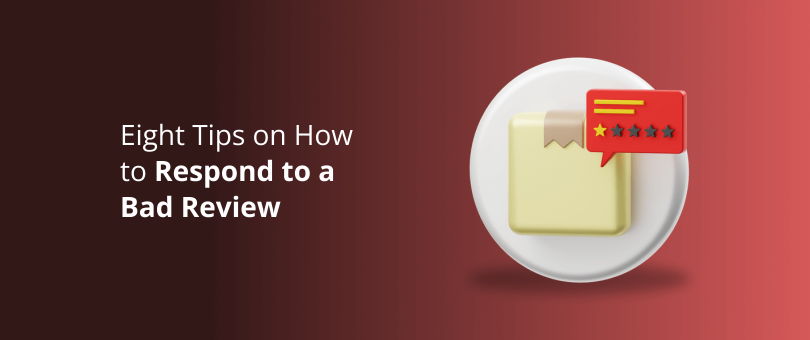Positive reviews from happy customers who recommend your product or services build trust in your future clients and make you happy too.
But, not all of your customers will be satisfied, so as a result, some of them may leave negative feedback. Well, how do you respond to a bad review?
This won’t be the end of the world – a couple of bad words here and there across your profiles on different networks won’t ruin your reputation and can even add authenticity to your brand.
But you need to be prepared for any customer feedback and create your approach on how to respond properly to the customers who have expressed dissatisfaction with your brand.
According to the statistics:
- Nearly nine out of ten consumers read reviews before making a purchase.
- 62% of consumers say they will not buy from brands that censor online reviews.
- Google is the most popular online review platform, and 57% of consumers use it to read reviews.
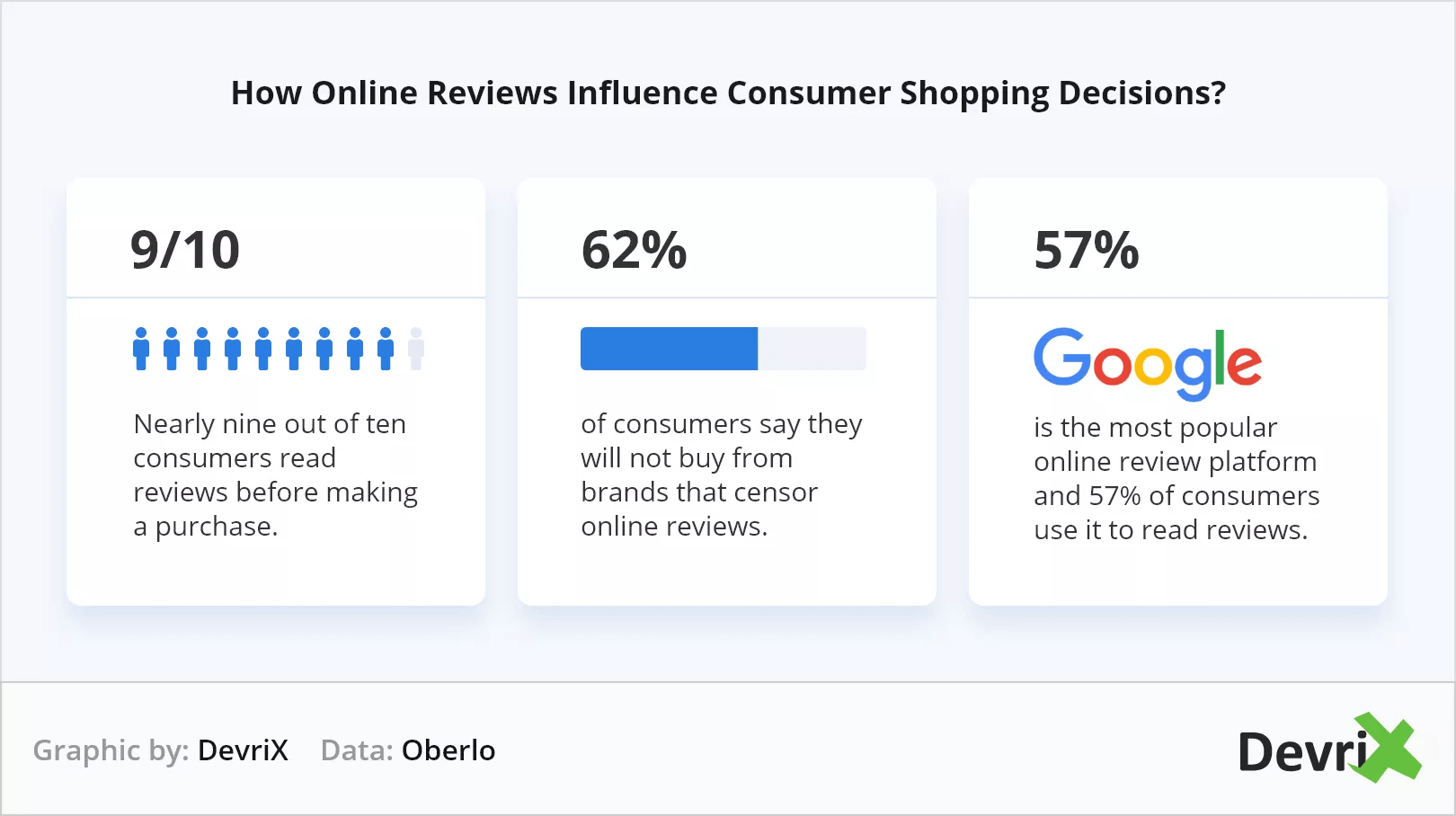
No matter good or bad, reviews are a powerful way to influence people’s decisions. Getting positive feedback shows that your customers trust you, and thus improves your company’s reputation. In contrast, negative reviews can drive away your clients and this is why you need a strategy on how to handle them. Moreover, you need to find the right way that will allow you to turn unsatisfied customers into loyal ones and avoid future negative experiences.
Readers Also Enjoy: How to Boost Your Reputation with Industry Research – DevriX
Here, we’ve compiled eight tips on how to respond to bad reviews, including how to delete one from Google.
How to Respond to a Bad Review
- Respond quickly.
- Make your response authentic and personalized.
- Prove this bad experience is a one-time exception.
- Thank the customer for the time to write the review.
- Move the conversation to private.
- Offer a compensation for the inconvenience.
- Follow up with the negative reviewer and request an update.
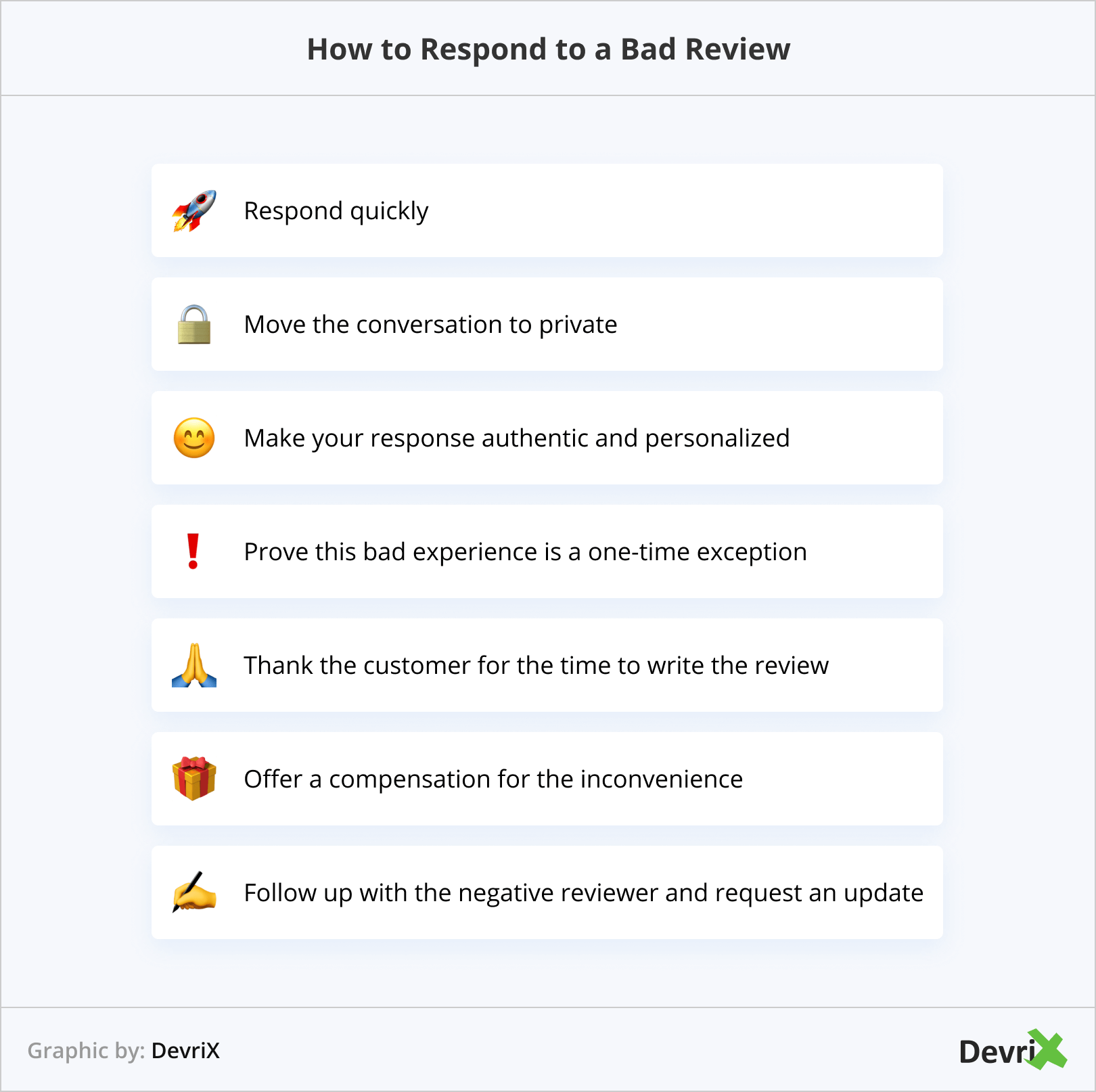
1. Respond Quickly
It’s never easy to read a bad review left by a customer. However, facing it is inevitable and the best thing you can do is to act quickly in a professional manner.
53% of customers expect businesses to reply to their negative reviews within a week, and 1 in 3 expect that to happen within three days. In addition, another 63% of the customers who leave negative feedback are disappointed if they don’t receive an answer from the company at all.
Often, when people leave a bad comment, they are upset, and they expect a prompt reply from the company. What you need to do is investigate quickly what has happened and answer back as soon as possible. This way, you will show that you appreciate your customers’ opinions.
2. Make Your Response Authentic and Personalized
Check out the straight forward apology by the founder and CEO of Amazon, Jeff Bezos, responding to dissatisfied customers when Amazon removed the copies of “1984” and other novels off the eBook readers.

Source: Social Media Examiner
Once you see a negative review from a client, read it carefully. Put yourself in your buyer’s shoes. You might need to investigate further by checking emails, orders or speaking with your employees who have interacted with the unsatisfied shopper.
Once you’ve figured out the actual details of the case, you can start drafting your reply.
When responding, offer your sincere apology for the bad experience and show empathy. People want to be heard. If a mistake has been made by your team – say it. Unhappy customers will be less hostile if you admit your fault.
Make sure to provide a personalized response and propose a solution to the problem that has arisen. Address your clients by their names, as this communicates respect and friendliness.
Even though some reviews can be really harsh and provide a misleading representation of the facts, you still need to act professionally.
Readers Also Enjoy: 6 Ways to Benefit from Personalized Marketing – DevriX
3. Prove This Bad Experience Is a One-Time Exception
In your response, keep in mind your audience and all current and future customers who might read the reviews. When crafting your answer, mention that this bad customer experience is just a single case and not part of your company practices.
Let the unhappy client know that your goal is to provide outstanding customer service, and his case is not a typical practice for your company. Express your concerns and show that you take the complaint seriously.
In the example below, Honda of Thousand Oaks responds to an unhappy client that has left a 1-star review on their page. In its response, the company states that its goal is the total satisfaction of our customers, and they ask for more details, so they can investigate.

Source: Paulshepherd
The response is also signed by the general manager, which adds more credibility and emphasizes that the company really cares about the positive experience of its customers.
Related article: How Brand Recognition Helps You Improve Customer Retention
4. Thank the Customer for the Time to Write the Review
The customer’s time is valuable, and their feedback is important. Be thankful to the clients who took the time to give you criticism, even if it’s harsh.
When you reply to unhappy customers, you can start with “Dear customer, thank you for taking the time to write a review”, for example. By answering promptly, you can turn negative reviews into a good experience for both you and your clientele.
This is also a great opportunity to hear something that could help you to improve your product or service and address any problems your clients are facing. If the bad experience is a result of your or your team’s mistakes, don’t forget to thank the clients for being honest and sharing their feedback.
They are actually making you a favor by reporting something that is not okay in your business or in your customer service, so you can even try to gain benefits from that situation.
5. Move the Conversation to Private
While you should publicly respond to your negative reviews, it’s a standard practice to move the conversation in private or offline. You can ask the shoppers how they prefer to continue the communication – over the phone, video call, chat, and email.
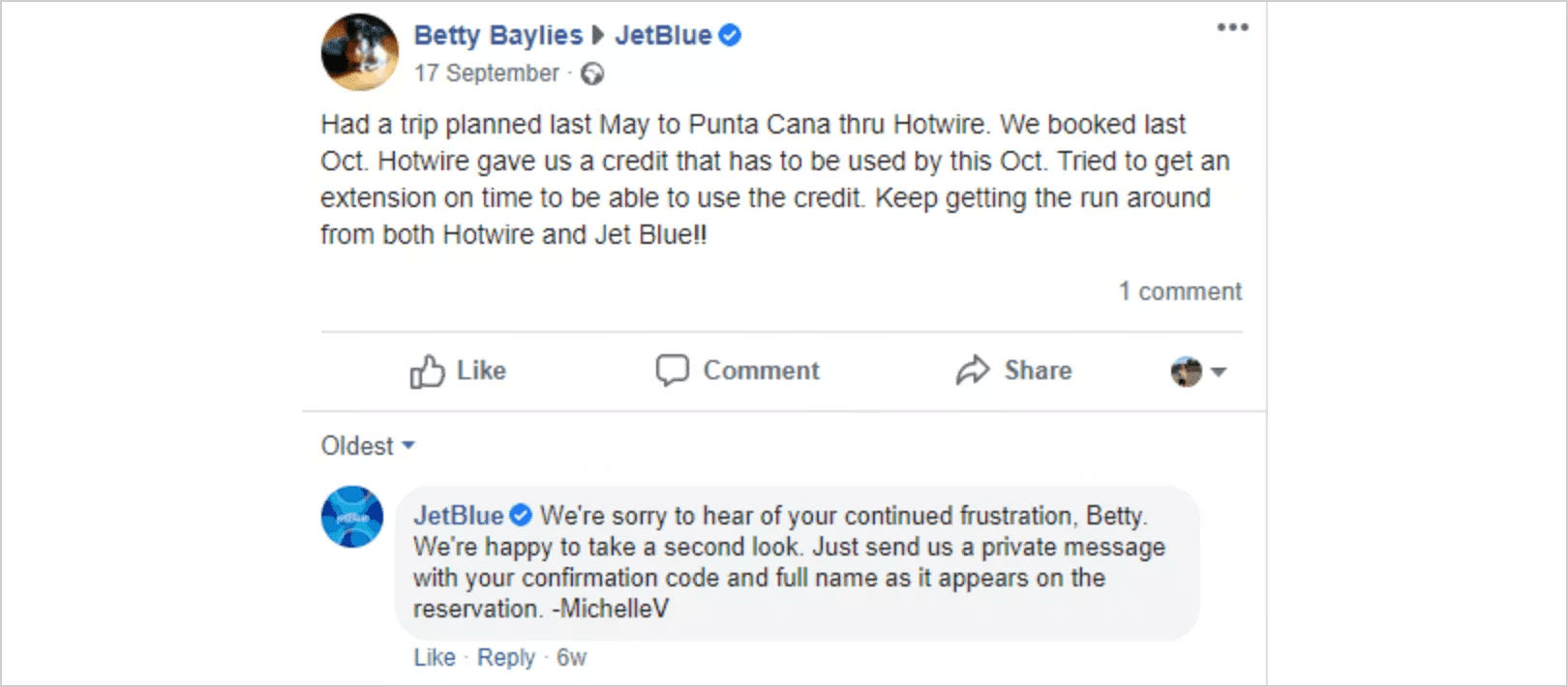
Source: JetBlue Facebook
Check the example by the American airline company JetBlue, how they answer to a customer on Facebook. They’ve addressed the buyer by name, they’ve apologized and offered to move the communication over to a private chat in order to investigate.
Once you’re talking in private, you will be able to dig deeper into the problem, explore in detail and offer a solution. The client might also feel more comfortable to share additional information on the bad experience.
In that way, you will express your willingness to help and find a resolution and will show that you take these cases seriously, and you care about your clientele.
If everything goes well, and you reach an agreement, you can even ask the person in private to delete or update the bad review.
Readers Also Enjoy: Four Ways to Re-Engage Your Customers for Better Retention – DevriX
6. Offer a Compensation for the Inconvenience
If this suits your business, you can offer a discount, gift, or even a refund to make the customer feel special and ease the tension.
It all depends on your business and the particular experience of the clients – if they’ve suffered a financial loss – compensation will be the logical solution.
On the other hand, if you’ve made an order or a shipping mistake, for example, a promo code, free delivery, or a gift might do the trick.
By providing a compensation, the client will be more likely to adjust its review, or even remove it and replace it with a positive one.
However, be careful with this practice, so you don’t teach your audience that you always give free stuff to people who write a bad review. You don’t want these cases to go public, so make sure you make any special offers in private, as mentioned above.
The example below is by the burrito chain, California Tortilla, and reveals their way of dealing with disappointed clients by saying they will make it up to them on their Twitter account.

Source: Social Media Examiner
7. Follow up With the Negative Reviewers and Request an Update
Once you’ve initiated a conversation with your prospects about the issue, make sure to follow up until the problem is resolved. The communication should end up as a happy customer experience and ideally, the person will update or delete the review.
Check the screenshot below as an example.
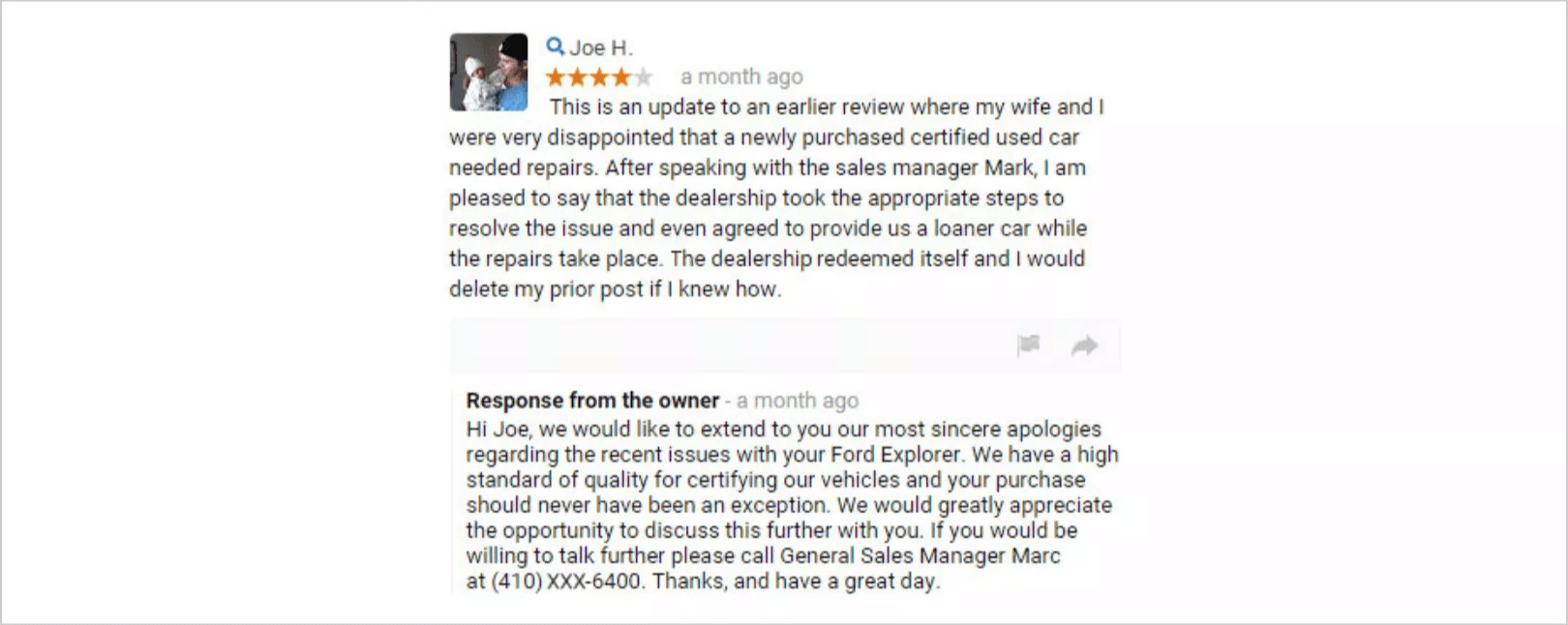
Source: Trustpulse
The customer, Joe, has addressed an issue in his previous review. It seems the problem got resolved, and he updated the review telling the rest of the world that his problem was dealt with, and he’s satisfied with the solution.
Bonus: How to Remove a Bad Google Review
Google takes first place among the top 10 consumer and business review websites. If you want to remove a bad review from Google because it is misleading, or it’s against the terms of service, actually you can do that.
The easiest way to remove a bad review from Google is directly to ask the reviewer to delete it.
However, sometimes it might happen that this is not a solution to the problem and the person is refusing to remove or update it, because he is still unhappy.
In this case, you need to respond publicly so the next customers who read it are aware that you’ve tried to provide a solution, and you are a company that values its clients’ feedback and does everything possible for them to be happy.
However, it might happen that you receive a malicious review that goes against Google’s content guidelines, meaning it’s spam, contains hate speech, or other questionable behavior. This is when you ask Google to delete it.
In order to do this, you need to sign in to Google My Business and go to the section with all your reviews.
Once you are there, find the specific review and flag it as “inappropriate”. Keep in mind that it could take a while to assess and it doesn’t guarantee that the review will be removed. If your review stays – your most powerful weapon is to respond to it and leave it as it is.
Wrapping Up
It’s good to know how to handle negative customer feedback and turn a bad review into a positive one.
However, it’s even better if you could avoid complaints from your clients. To achieve that you can follow a couple of simple rules:
- Have an impeccable product or service.
- Make sure you are easy to contact.
- Respond quickly to your shoppers’ queries.
- Encourage happy buyers to leave reviews.
How do you handle negative customer feedback? Share your tips with us in the comment section below.
